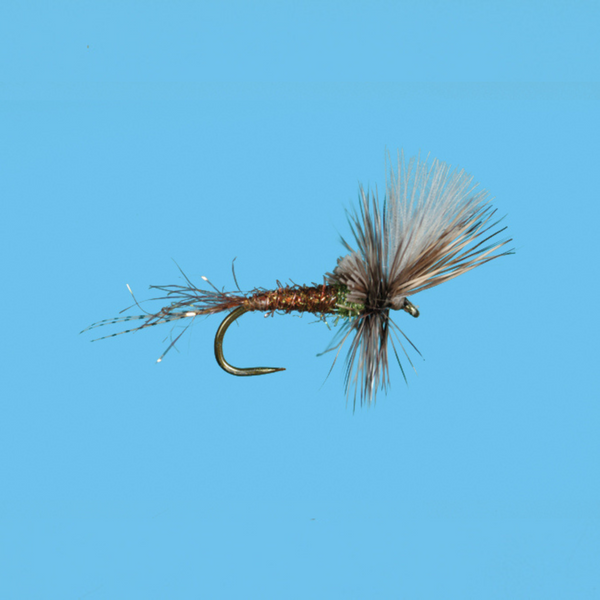
Umpqua Feather Merchants
Poxyback Dark Stone
$ 3.25
SKU 1048Mercer's Gold Bead Biot Epoxy Dark Stonefly
The Story of Mercer's Gold Bead Biot Epoxy Dark Stonefly
Mike Mercer is a truly exceptional modern fly tyer, notably for his clever uses of natural and synthetic materials. His ingenious series of "Poxyback" mayfly nymph patterns exemplify this ability to mash up materials to create a wildly effective fly.
Mercer's Gold Bead Biot Epoxy Dark Stonefly is the logical extension of the Poxyback style from the mayfly to the stonefly and serves as an excellent imitation of the black stonefly (giant salmonfly) in its mature nymph or emerger life stage. With its thin profile, biot-wrapped body, wiggly feather gills, gold bead head, and "wet" epoxy shell, this smartly dressed fly is sure to pick a fight with the biggest steelhead and trout in your favorite pool!
When and Where to Fish Mercer's Gold Bead Biot Epoxy Dark Stonefly
This medium sized stonefly nymph can be fished as either an impressionistic fly pattern when searching for trout or as a realistic imitation when matching the hatch. When searching, fish this fly in riffles, well defined current seams, areas below faster currents, and near exposed rocky structure and streamside vegetation. Shallow water near the river bank will also be productive when fishing a black stonefly hatch, so be sure to survey the scene thoroughly. These nymphs do not possess strong swimming ability, however, and are often swept into the main current’s drift – look for these floating specimens in the main drift as well as shallower, less energetic water near sheltered areas. Prior to and during emergence, an angler will easily spot these nymphs crawling from the rocky depths to the shallower water along the river bank and eventually to the surface of exposed rocks and vegetation to shed their shucks and hatch into winged adults.
How to Fish Mercer's Gold Bead Biot Epoxy Dark Stonefly
Fish this fly in a variety of water types; because of their aggressive and migratory feeding nature, strong crawling ability, and widespread proliferation in all kinds of trout water, just about anywhere within a healthy aquatic ecosystem can be prime real estate for black stonefly nymphs. These nymphs will often be carried away by stronger currents. The giant salmonfly is a poor swimmer and is unable to fight the power of the main drift and will ride the wave until the energy decreases and they are deposited back onto the safety of the river bottom. When these nymphs are caught in the drift, they are quite vulnerable to feeding trout and will quickly meet their match. A popular strategy is to fish these patterns on a dead drift right through the main current – drifting a black stonefly nymph through faster riffles, current seams, and the slower water just below these areas can yield excellent results. Stonefly nymphs emerge after crawling to the safety of the shoreline rather than shedding their nymphal shucks in the water’s surface film like mayflies. This pre- and during-emergence behavior renders shallower streamside water quite productive just prior to and during a black stonefly emergence and hatch. Always be sure to cast far enough upstream to allow your black stonefly nymph time to sink; this species spends most of its 2 or 3 years as a nymph in the lower portions of the water column. Black stones make themselves available throughout the day all year long. Trout prey on them hungrily and voraciously, so don’t be surprised when you feel an aggressive take – set the hook confidently and with care if you happen to be fishing with lighter leaders and tippet material!
Summary
- This fly pattern was developed by creative fly tyer, Mike Mercer, as an extension of his wildly effective poxyback series of mayfly nymph patterns
- Black stonefly (giant salmonfly) imitation in the mature nymph or emerger life stage
- Use as either an impressionistic searching fly or as a realistic imitation when matching the hatch
- Drift the fly through different water types; faster riffles and shallower water near the banks of a river with moderate to slow currents are the most productive water types for this fly
- Black stonefly nymphs are available to trout all year long in trout water throughout North America
- Hatches occur consistently and with long duration throughout the daylight hours
- Strikes on black stoneflies are often far from subtle because trout must often be prepared to rip these strong clingers from their rocky homes
- When approaching a shallow water environment with a stonefly nymph, be extremely careful not to spook happily feeding trout
- Added weight of gold bead head will keep the fly low in the water column
- Slim profile with buggy feather gills gives a realistic appearance to this fly pattern





